Experiment – 1
Question. Ethanoic acid was added to sodium bicarbonate solution and the gas evolved was tested with a burning splinter. The following four observations were reported.
(1) The gas burns with the pop sound and the flame gets extinguished.
(2) The gas does not burn but the splinter burns with a pop sound.
(3) The flame extinguishes and the gas does not burn.
(4) The gas burns with a blue flame and the splinter burns brightly.
The correct observation is reported in
(a) 1
(b) 2
(c) 3
(d) 4
Answer
C
Question. Vapours of acetic acid smell
(a) pungent like vinegar
(b) sweet like rose
(c) suffocating like sulphur dioxide
(d) odourless like water.
Answer
A
Question. What do we observe on pouring acetic acid on red and blue litmus papers?
(a) Red litmus remains red and blue litmus turns red.
(b) Red litmus turns blue and blue litmus remains blue.
(c) Red litmus turns blue and blue litmus turns red.
(d) Red litmus becomes colourless and blue litmus remains blue.
Answer
A
Question. A student takes four test tubes marked A, B, C and D containing NaCl, Na2CO3, NaHCO3 and NaOH respectively. He adds acetic acid to the test tubes one by one and every time he immediately brings a lighted matchstick near to the mouth of the test tube. He observes that the match-stick extinguishes in the cases of
(a) A and B
(b) B and C
(c) C and D
(d) D and A
Answer
B
Question. A student adds a few drops of ethanoic acid to test tubes X, Y and Z containing aqueous solutions of sodium chloride, sodium hydroxide and sodium carbonate respectively.
If he now brings a burning splinter near the mouth of the test tubes immediately after adding the ethanoic acid in each one of them, in which of the test tube or test tubes the flame gets extinguished?
(a) X and Y
(b) Y and Z
(c) X and Z
(d) only Z.
Answer
D
Question. When you add about 2 mL of acetic acid to a test tube containing an equal amount of distilled water and leave the test tube to settle after shaking its contents, then after about 5 minutes what will you observe in the test tube
(a) a white precipitate settling at its bottom.
(b) a clear colourless solution.
(c) a layer of water over the layer of acetic acid, or
(d) a layer of acetic acid over the layer of water.
Answer
B
Question. In an experiment to study the properties of ethanoic acid, a student takes about 3 mL of ethanoic acid in a dry test tube. He adds an equal amount of distilled water to it and shakes the test tube well. After some time he is likely to observe that
(a) a colloid is formed in the test tube
(b) the ethanoic acid dissolves readily in water
(c) the solution becomes light orange
(d) water floats over the surface of ethanoic acid.
Answer
B
Question. A student mixed some acetic acid with water.
He would have observed the solution formed as
(a) green and transparent
(b) pink and opaque
(c) yellow and transparent
(d) colourless and transparent.
Answer
D
Question. A student takes a small quantity of sodium hydrogen carbonate powder in a dry test tube and pours 4-5 drops of ethanoic acid over it. What will he observe ?
(a) Evolution of a colourless gas with pungent smell.
(b) Bubbles of a colourless and odourless gas.
(c) Evolution of brown fumes along with a brisk effervescence.
(d) Evolution of a colourless gas which burns with a pop sound when a burning splinter is brought near it.
Answer
B
Question. Four students P, Q, R and S studied the properties of ethanoic acid and reported their observations in the following table :
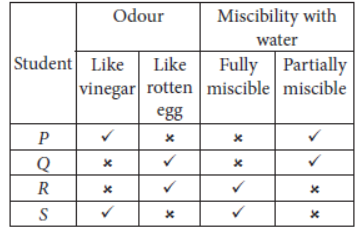
The correctly reported observations are of
(a) P
(b) Q
(c) R
(d) S
Answer
D
Question. In an experiment to study the properties of acetic acid a student takes about 2 mL of acetic acid in a dry test tube. He adds about 2 mL of water to it and shakes the test tube well. He is likely to observe that
(a) the acetic acid dissolves readily in water
(b) the solution becomes light orange
(c) water floats over the surface of acetic acid
(d) acetic acid floats over the surface of water.
Answer
A
Question. 2 mL of acetic acid was added in drops to 5 mL of water and it was noticed that
(a) the acid formed a separate layer on the top of water
(b) water formed a separate layer on the top of the acid
(c) a clear and homogeneous solution was formed
(d) a pink and clear solution was formed.
Answer
C
Question. A student adds some water to 5 mL of ethanoic acid taken in a test tube and shakes it. He gets
(a) a clear solution
(b) a milky solution
(c) a layer of water over a layer of acid
(d) a layer of acid over a layer of water.
Answer
A
Question. On shaking acetic acid with water
(a) a colloidal solution is formed
(b) a suspension is formed
(c) a homogeneous mixture is formed
(d) a heterogeneous mixture is formed.
Answer
C
Question. When a student adds NaHCO3 to some ethanoic acid taken in a test tube, he observes
(a) no reaction taking place
(b) a milky solution
(c) effervescence of a gas
(d) green coloured vapours.
Answer
C
Question. In a litmus test, it is observed that an aqueous solution of acetic acid turns
(a) blue litmus colourless
(b) blue litmus red
(c) red litmus blue
(d) red litmus colourless.
Answer
B
Question. As observed in the school laboratory, acetic acid is
(a) blue in colour and has a fruity smell
(b) colourless and smells like vinegar
(c) colourless and has no odour.
(d) colourless and smells like rotten eggs.
Answer
B
Question. Which of the following observations is true about dilute solution of acetic acid?
(a) It smells like vinegar and turns red litmus blue.
(b) it smells like onion and turns blue litmus red.
(c) It smells like orange and turns red litmus blue.
(d) It smells like vinegar and turns blue litmus red.
Answer
D
Question. Acetic acid reacts with solid sodium hydrogen carbonate
(a) slowly forming no gas
(b) vigorously with effervescence
(c) slowly without effervescence
(d) vigorously without gas formation.
Answer
B
Question. A student takes Na2CO3 powder in a test tube and pours some drops of acetic acid over it. He observes
(a) no reaction in the test tube
(b) colourless gas with pungent smell
(c) bubbles of a colourless and odourless gas
(d) white fumes with smell of vinegar.
Answer
C
Question. A student adds 4 mL of acetic acid to a test tube containing 4 mL of distilled water. He then shakes the test tube and leaves it to settle. After about 10 minutes he observes
(a) a layer of water over the layer of acetic acid
(b) a layer of acetic acid over the layer of water
(c) a precipitate settling at the bottom of the test tube
(d) a clear colourless solution.
Answer
D
Question. On adding 2 mL acetic acid to 2 mL of water in a test tube, it was observed that
(a) a clear and transparent solution is formed
(b) a white precipitate is formed almost immediately
(c) two separate layers were formed
(d) a colourless and odourless gas is evolved.
Answer
A
Question. On adding acetic acid to solid sodium hydrogen carbonate, a student observes the liberation of a
(a) greenish yellow gas with a pungent smell
(b) colourless and odourless gas
(c) yellow coloured, odourless gas
(d) colourless gas with smell of rotten eggs.
Answer
B
Question. A student takes about 2 mL ethanoic acid in a dry test tube and adds a pinch of sodium hydrogen carbonate to it. He reports the following observations :
I. Immediately a colourless and odourless gas evolves with a brisk effervescence.
II. The gas turns lime water milky when passed through it.
III. The gas burns with an explosion when a burning splinter is brought near it.
IV. The gas extinguishes the burning splinter that is brought near it.
The correct observations are
(a) I, II and III
(b) II, III and IV
(c) III, IV, and I
(d) I, II and IV
Answer
D
Question. When you add a few drops of acetic acid to a test-tube containing sodium bicarbonate powder, which one of the following is your observation?
(a) No reaction takes place.
(b) A colourless gas with pungent smell is released with brisk effervescence.
(c) A brown coloured gas is released with brisk effervescence.
(d) Formation of bubbles of a colourless and odourless gas.
Answer
D
Question. A solid sodium bicarbonate is added to a dilute aqueous solution of ethanoic acid
(a) brisk effervesence takes place and an odourless gas is evolved
(b) brisk effervesence takes place and a pungent smelling gas is evolved
(c) no effervescence occurs and no gas is evolved
(d) brisk effervescence occurs and a gas is evolved which helps a glowing splinter to burn with a flame.
Answer
A
Question. Acetic acid solution turns
(a) blue litmus red
(b) red litmus blue
(c) blue litmus colourless
(d) red litmus colourless.
Answer
A
Question. A student adds 2 mL of acetic acid to a test tube containing 2 mL of distilled water. He then shakes the test tube well and leaves it to settle for some time. After about 5 minutes he observes that in the test tube there is
(a) a clear transparent colourless solution
(b) a clear transparent pink solution
(c) a precipitate settling at the bottom of the test tube
(d) a layer of water over the layer of acetic acid.
Answer
A
Question. On adding NaHCO3 to acetic acid, a gas is evolved which turns lime water milky due to the formation of
(a) calcium bicarbonate
(b) calcium hydroxide
(c) calcium carbonate
(d) calcium acetate.
Answer
C
Question. A student added acetic acid to test tubes I, II, III and IV containing the labelled substances and then brought a burning splinter near the mouth of each test tube.
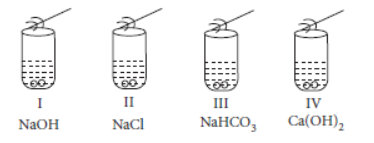
The splinter would be extinguished when brought near the mouth of test tube.
(a) I
(b) II
(c) III
(d) IV
Answer
C
Question. On adding acetic acid to sodium hydrogen carbonate in a test tube, a student observes
(a) no reaction
(b) a colourless gas with pungent smell
(c) bubbles of a colourless and odourless gas
(d) a strong smell of vinegar.
Answer
C
Question. Four students added a small amount of ethanoic acid to sodium bicarbonate. The gas evolved was tested for its behaviour with burning splinter and lime water.
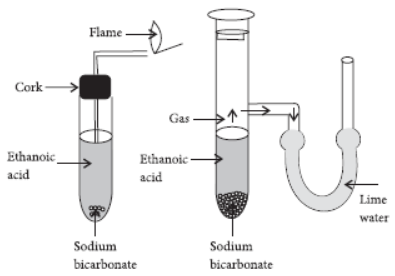
They reported their observations as given below

The correct observations have been reported by student
(a) A
(b) B
(c) C
(d) D
Answer
A
Question. Which of the following pairs of safety symbols are marked on the bottles of commercial acetic acid available in the laboratory?
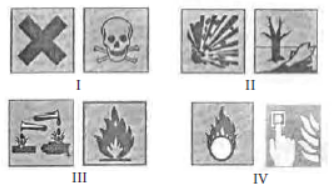
(a) I
(b) II
(c) III
(d) IV
Answer
C
Question. Four students observed the colour and odour of acetic acid and its reaction with sodium hydrogen carbonate. They tabulated their observations as given below.

The correct set of observations is that of student :
(a) A
(b) B
(c) C
(d) D
Answer
B
Question. Which one of the following are the correct observations about acetic acid?
(a) It turns blue litmus red and smells like vinegar.
(b) It turns blue litmus red and smells like burning sulphur.
(c) It turns red litmus blue and smells like vinegar.
(d) It turns red litmus blue and has a fruity smell.
Answer
A
Question. Acetic acid smells like
(a) an orange
(b) an onion
(c) lemon juice
(d) vinegar.
Answer
D
Question. A student adds a spoon full of powdered sodium hydrogen carbonate to a flask containing ethanoic acid. List two main observations, he must note in his note book, about the reaction that takes place. Also write chemical equation for the reaction.
Answer
Student will observe the following changes :
– there will be brisk effervescence of CO2 in the flask of reaction mixture.
– there will be evolution of colourless and odourless gas and some amount of heat will be released.
CH3COOH + NaHCO3 → CH3COONa
Acetic acid Sodium Sodium
bicarbonate acetate + H2O + CO2 ↑
Question. A student is studying the properties of acetic acid in his school laboratory. List two physical and two chemical properties which he must observe and note in his record book.
Answer
The two physical properties are :
(i) it smells like vinegar.
(ii) it is a colourless liquid.
The two chemical properties of acetic acid are :
(i) it turns blue litmus paper to red showing that
it is acidic in nature.
(ii) it gives brisk effervescence when it reacts with
sodium carbonate due to evolution of CO2 gas.
2CH3COOH + Na2CO3 →2CH3COO–Na+ + CO2 ↑+ H2O
Question. A student is studying the properties of acetic acid. List two physical properties of acetic acid, he observes. What happens when he adds a pinch of sodium hydrogen carbonate to this acid? Write any two observations.
Answer
Two physical properties of acetic acid are :
(i) it readily dissolves in water.
(ii) it smells like a vinegar.
When sodium hydrogen carbonate is added to this acid, carbon dioxide gas is released with the brisk effervescence. The gas evolved is colourless and odourless.
CH3COOH + NaHCO3 →CH3COONa + CO2↑ + H2O
Question. A gas is liberated immediately with a brisk effervescence, when you add acetic acid to sodium hydrogen carbonate powder in a test tube. Name the gas and describe the test that conflrms the identity of the gas.
Answer
Carbon dioxide gas is liberated with a brisk effervescence when acetic acid is added to sodium hydrogen carbonate.
CH3COOH + NaHCO3 → CH3COONa + CO2 + H2O
The gas is carbon dioxide which when passed through lime water turns it milky due to the formation of insoluble calcium carbonate.
Ca(OH)2 + CO2 → CaCO3 ↓ + H2O
Calcium
carbonate
(insoluble)
Question. What do you observe when you drop a few drops of acetic acid to a test tube containing
(a) phenolphthalein
(b) distilled water
(c) universal indicator
(d) sodium hydrogen carbonate powder?
Answer
(a) Acetic acid when added to phenolphthalein solution then there is no reaction and it remains colourless.
(b) Acetic acid gets dissolved in distilled water.
(c) Acetic acid turns the colour of universal indicator to orange.
(d) When acetic acid is added sodium hydrogen carbonate powder then there is evolution of colourless, odourless gas with a brisk effervescence.
Experiment – 2
Question. A student takes four test tubes marked P, Q, R and S of 25 mL capacity and fill 10 mL of distilled water in each. He dissolves one spoon full of four different salts in each as –KCl in P, NaCl in Q, CaCl2 in R and MgCl2 in S. He then adds about 2 mL of a sample of soap solution to each of the above test tubes.
On shaking the contents of each of the test tubes, he is likely to observe a good amount of lather (foam) in the test tubes marked
(a) P and Q
(b) R and S
(c) P, Q and R
(d) P, Q and S.
Answer
A
Question. A student is testing water to know which is best for cleansing purposes with soaps. He would find that the cleansing action of soap is best when he uses water obtained from
(a) rain
(b) tap
(c) hand pump
(d) pond.
Answer
A
Question. Which of the following is not used for preparing soap in a school laboratory?
(a) Castor oil
(b) Coconut oil
(c) Mineral oil
(d) Cottonseed oil
Answer
C
Question. Consider the following comments about saponification reactions:
I. Heat is evolved in these reactions.
II. For quick precipitation of soap, sodium chloride is added to the reaction mixture.
III. Saponification reactions are special kind of neutralisation reactions.
IV. Soaps are basic salts of long chain fatty acids.
The correct comments are
(a) I, II and III
(b) II, III and IV
(c) I, II and IV
(d) Only I and IV.
Answer
C
Question. A student puts a drop of reaction mixture of a saponification reaction first on a blue litmus paper and then on a red litmus paper. He may observe that
(a) there is no change in the blue litmus paper and the red litmus paper turns white
(b) there is no change in the red litmus paper and the blue litmus paper turns red
(c) there is no change in the blue litmus paper and the red litmus paper turns blue
(d) no change in colour is observed in both the litmus papers.
Answer
C
Question. In a locality, hard water required for an experiment is not available. However, the following salts are available in the school laboratory :
1. Sodium sulphate
2. Calcium sulphate
3. Magnesium chloride
4. Sodium chloride 5. Calcium chloride
6. Potassium sulphate
Which of the above salts may be dissolved in water to obtain hard water for the experiment?
(a) 2, 3 and 5
(b) 1, 2 and 5
(c) 1, 2, 4 and 6
(d) 3 and 5 only
Answer
A
Question. For preparing soap in the laboratory we require an oil and a base. Which of the following combinations of an oil and a base would be best suited for the preparation of soap?
(a) Castor oil and calcium hydroxide.
(b) Turpentine oil and sodium hydroxide.
(c) Castor oil and sodium hydroxide.
(d) Mustard oil and calcium hydroxide.
Answer
C
Question. A student took four test tubes P, Q, R and S and filled about 8 mL of distilled water in each. After that he dissolved an equal amount of Na2SO4 in P, K2SO4 in Q, CaSO4 in R and MgSO4 in S. On adding an equal amount of soap solution and shaking each test tube well, a good amount of lather will be obtained in the test tubes.
(a) P and Q
(b) P and R
(c) P, Q and S
(d) Q, R and S.
Answer
A
Question. A student requires hard water for an experiment in his laboratory which is not available in the neighbouring area. In the laboratory there are some salts, which when dissolved in distilled water can convert it into hard water. Select from the following groups of salts, a group, each salt of which when dissolved in distilled water will make it hard.
(a) Sodium chloride, Potassium chloride
(b) Sodium sulphate, Potassium sulphate
(c) Sodium sulphate, Calcium sulphate
(d) Calcium sulphate, Calcium chloride
Answer
D
Question. Which of the following chemicals do you use for preparing soap in your laboratory?
(a) Sodium hydroxide
(b) Magnesium hydroxide
(c) Calcium hydroxide
(d) Sodium carbonate
Answer
A
Question. While studying the saponification reaction, what do you observe when you mix an equal amount of colourless vegetable oil and 20% aqueous solution of NaOH in a beaker?
(a) The colour of the mixture has become dark brown.
(b) A brisk effervescence is taking place in the beaker.
(c) The outer surface of the beaker has become hot.
(d) The outer surface of the beaker has become cold.
Answer
C
Question. A student prepared 20% sodium hydroxide solution in a beaker to study saponification reaction. Some observations related to this are given below :
I. Sodium hydroxide solution turns red litmus blue.
II. Sodium hydroxide readily dissolves in water.
III. The beaker containing solution appears cold when touched from outside.
IV. The blue litmus paper turns red when dipped into the solution.
The correct observations are
(a) I, II and IV
(b) I, II and III
(c) Only III and IV
(d) Only I and II
Answer
D
Question. While preparing soap a small quantity of common salt is generally added to the reaction mixture of vegetable oil and sodium hydroxide. Which one of the following may be the purpose of adding common salt?
(a) To reduce the basic nature of the soap.
(b) To make the soap neutral.
(c) To enhance the cleansing power of the soap.
(d) To favour the precipitation of the soap.
Answer
D
Question. In the neighbourhood of your school, hard water required for an experiment is not available. Select from the following groups of salts available in your school, a group each member of which, if dissolved in distilled water, will make it hard
(a) Sodium chloride, calcium chloride
(b) Potassium chloride, sodium chloride
(c) Sodium chloride, magnesium chloride
(d) Calcium chloride, magnesium chloride.
Answer
D
Question. A student takes about 4 mL of distilled water in four test tubes marked P, Q, R and S. He then dissolves in each test tube an equal amount of one salt in one test tube, namely sodium sulphate in P, potassium sulphate in Q, calcium sulphate in R and magnesium sulphate in S. After that he adds an equal amount of soap solution in each test tube.
On shaking each of these test tubes well, he observes a good amount of lather (foam) in the test tubes marked
(a) P and Q
(b) Q and R
(c) P, Q and S
(d) P, R and S
Answer
A
Question. While studying saponification reaction, a student measures the temperature of the reaction mixture and also finds its nature using blue/red litmus paper. On the basis of his observations the correct conclusion would be
(a) the reaction is exothermic and the reaction mixture is acidic
(b) the reaction is endothermic and the reaction mixture is acidic
(c) the reaction is endothermic and the reaction mixture is basic
(d) the reaction is exothermic and the reaction mixture is basic.
Answer
D
Question. While studying saponification reaction for the preparation of soap, the teacher suggested to a student to add a small quantity of common salt to the reaction mixture. The function of common salt in this reaction is to
(a) reduce the alkalinity of the soap
(b) reduce the acidity of the soap
(c) enhance the cleansing capacity of soap
(d) favour precipitation of soap.
Answer
D
Question. A student takes about 6 mL of distilled water in each of the four test tubes P, Q, R and S, then dissolves an equal amount of four different salts namely sodium chloride in P, potassium chloride in Q, calcium chloride in R and magnesium chloride in S. He then adds 10 drops of soap solution to each test tube and shake its contents. The test tubes in which scum (insoluble substance) is formed with soap are
(a) P and Q
(b) Q and R
(c) R and S
(d) Q and S
Answer
C
Question. We need 20% aqueous solution of sodium hydroxide for the study of saponification reaction. When we open the lid of the bottle containing solid sodium hydroxide we observe it in which form?
(a) Colourless transparent beads
(b) Small white beads
(c) White pellets/flakes
(d) Fine white powder
Answer
C
Question. Which of the following sets of materials can be used for conducting a saponification reaction for the preparation of soap?
(a) Ca(OH)2 and neem oil
(b) NaOH and neem oil
(c) NaOH and mineral oil
(d) Ca(OH)2 and mineral oil
Answer
B
Question. Hard water is not available for an experiment.
Some salts are given below.
I. Sodium chloride
II. Sodium sulphate
III. Calcium chloride
IV. Calcium sulphate
V. Potassium chloride
VI. Magnesium sulphate
Select from the following a group of these salts, each member of which may be dissolved in water to make it hard.
(a) I, II, V
(b) I, III, V
(c) III, IV, VI
(d) II, IV, VI
Answer
C
Question. Read the following statements :
I. When a red litmus paper is dipped into a reaction mixture of a saponification reaction, it turns blue and the reaction is exothermic.
II. When a blue litmus paper is dipped into a reaction mixture of a saponification reaction, its colour does not change and the reaction is exothermic.
III. When a red litmus paper is dipped into a reaction mixture of a saponification reaction, its colour does not change and the reaction is endothermic.
IV. When a blue litmus paper is dipped into a reaction mixture of a saponification reaction, its colour does not change and the reaction is endothermic.
Which of the above statements are correct?
(a) I and II
(b) II and III
(c) III and IV
(d) I and IV
Answer
A
Question. In order to study saponification reaction we first prepare 20% solution of sodium hydroxide, if we record the temperature of this solution just after adding sodium hydroxide flakes to water and also test its nature using litmus, it may be concluded that the process of making this solution is
(a) exothermic and the solution is alkaline
(b) endothermic and the solution is alkaline
(c) endothermic and the solution is acidic
(d) exothermic and the solution is acidic.
Answer
A
Question. Hard water required for an experiment is not available in a school laboratory. However following salts are available in the laboratory.
Select the salts which may be dissolved in water to make it hard for the experiment.
(1) Calcium sulphate
(2) Sodium sulphate
(3) Calcium chloride
(4) Potassium sulphate
(5) Sodium hydrogen carbonate
(6) Magnesium chloride
(a) 1, 2 and 4
(b) 1, 3 and 6
(c) 3, 5 and 6
(d) 2, 4 and 5
Answer
B
Question. Consider the following oils.
(I) Mobil oil
(II) Castor oil
(III) Turpentine oil (IV) Kerosene
(V) Mustard oil
(VI) Coconut oil
Which of these can be used for preparation of soap?
(a) I, II, III, VI
(b) II, V, VI
(c) II, III, V, VI
(d) II, III, VI
Answer
B
Question. The chemical mostly used in the preparation of most of the soaps we use is
(a) sodium chloride
(b) potassium hydroxide
(c) sodium hydroxide
(d) potassium chloride.
Answer
C
Question. Mention the essential material (chemicals) to prepare soap in the laboratory. Describe in brief the test of determining the nature (acidic/alkaline) of the reaction mixture of saponification reaction.
Answer
Essential material required to prepare soap in laboratory are fatty acids (like palmitic acid, stearic acid), NaOH. To determine the nature of reaction mixture of saponification, put a drop of mixture on red litmus paper, then it turns blue.
Which indicates the alkaline nature of reaction mixture.
Experiment – 3
Question. The focal length of the concave mirror in the experimental set up shown below, equals
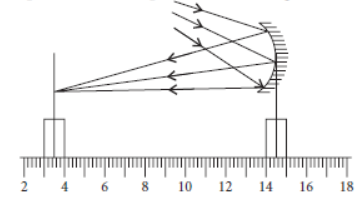
(a) 10.3 cm
(b) 11.0 cm
(c) 11.7 cm
(d) 12.2 cm
Answer
B
Question. Study the following diagram and select the correct statement about the device X.
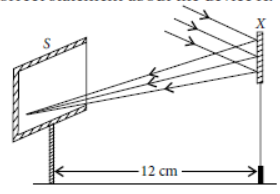
(a) Device X is a concave mirror of radius of curvature 12 cm.
(b) Device X is a concave mirror of focal length 6 cm.
(c) Device X is a concave mirror of focal length 12 cm.
(d) Device X is a convex mirror of focal length 12 cm.
Answer
C
Question. Study the given ray diagrams and select the correct statement from the following.

(a) Device X is a concave mirror and device Y is a convex lens, whose focal lengths are 20 cm and 25 cm respectively.
(b) Device X is a convex lens and device Y is a concave mirror, whose focal lengths are 10 cm and 25 cm respectively.
(c) Device X is a concave lens and device Y is a convex mirror, whose focal lengths are 20 cm and 25 cm respectively.
(d) Device X is a convex lens and device Y is a concave mirror, whose focal lengths are 20 cm and 25 cm respectively
Answer
D
Question. A student obtains a sharp image of the distant window (W) of the school laboratory on the screen (S) using the given concave mirror (M) to determine its focal length. Which of the following distances should he measure to get the focal length of the mirror?
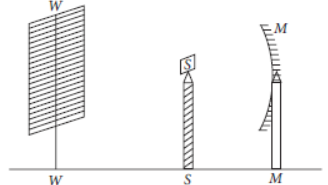
(a) MW
(b) MS
(c) SW
(d) MW – MS
Answer
B
Question. A student obtained a sharp image of a candle flame placed at the distant end of the laboratory table on a screen using a concave mirror to determine its focal length. The teacher suggested him to focus a distant building about 1 km far from the laboratory, for getting more correct value of the focal length. In order to focus the distant building on the same screen the student should slightly move the
(a) mirror away from the screen
(b) screen away from the mirror
(c) screen towards the mirror
(d) screen towards the building
Answer
C
Question. Mohan, Sohan and Rahul separately measured the focal length of the same convex lens using the same distant tree as object. All of them measured the distance between the lens and the inverted image of the tree on the screen.
Mohan obtained a sharp image on the screen and labelled the measured distance as f1.
Sohan obtained a slightly smaller and somewhat blurred image on the screen. He labelled the measured distance as f2.
Rahul obtained a magnified and blurred image on the screen. He labelled the measured distance as f3.
The three measured values of focal length are likely to be related as
(a) f1 < f2 and f1 = f3
(b) f1 < f2 and f1 < f3
(c) f3 > f1 > f2
(d) f1 = f2 = f3
Answer
C
Question. A student performs an experiment, on finding the focal length of a convex lens by keeping a lighted candle on one end of the laboratory table, a screen on its other end and the lens between them as shown in the figure. The positions of the three are adjusted to get a sharp image of the candle flame on the screen. If now the candle flame were to be replaced by a distant lamp on a far away electric pole, the student would be able to get a sharp image of this distant lamp on the screen by moving
(a) the screen in the direction of the lens or the lens in the direction of the screen.
(b) the screen in the direction of the lens or the lens away from the screen.
(c) the screen away from the lens or the lens in the direction of the screen.
(d) neither the screen nor the lens.
Answer
A
Question. To determine the focal length of a convex lens by obtaining a sharp image of a distant object, we generally follow the following steps which are not in proper sequence
(A) Hold the lens between the object and the screen
(B) Measure the distance between the lens and the screen
(C) Select a well lit distant object
(D) Place a screen opposite to the object on the lab table
(E) Adjust the position of the lens to form a sharp image The correct sequence of these steps is
(a) C, A, D, E, B
(b) C, D, A, E, B
(c) C, D, E, A, B
(d) C, A, E, D, B
Answer
B
Question. A student used a device (X) to obtain/focus the image of a well illuminated distant building on a screen as shown below in the diagram. Select the correct statement about the device (X). 13
(a) This device is a concave lens of focal length 8 cm.
(b) This device is a convex mirror of focal length 8 cm.
(c) This device is a convex lens of focal length 4 cm.
(d) This device is a convex lens of focal length 8 cm.
Answer
D
Question. Three students A, B and C focussed a distant building on a screen with the help of a concave mirror. To determine focal length of the concave mirror they measured the distances as given below :
Student A : From mirror to the screen
Student B : From building to the screen
Student C : From building to the mirror
Who measured the focal length correctly :
(a) Only A
(b) Only B
(c) A and C
(d) B and C
Answer
A
Question. A student has obtained a highly diminished image of the Sun on a screen using a convex lens. In order to determine the focal length of the lens, what should he measure?
(a) Curvature of two surfaces of the lens
(b) Aperture of the lens
(c) Distance of the screen from the lens
(d) Radius of curvature of two surfaces of the lens
Answer
C
Question. A student determines the focal length of a device X, by focussing the image of a far of object on the screen positioned as shown in the figure. The device X is

(a) convex lens
(b) concave lens
(c) convex mirror
(d) concave mirror
Answer
D
Question. Dhoni obtained the image of a distant object on a screen by using a concave mirror. To find the focal length of the mirror, he should measure the distance between
(a) a mirror and the screen as well as between object and the screen
(b) mirror and the screen
(c) object and the screen
(d) object and the mirror
Answer
B
Question. A student used a device X to obtain the image of a well illuminated distant building on a screen S as shown below in the diagram. Select the correct statement about the device X.

(a) The device X is a convex lens of focal length 10 cm.
(b) The device X is a convex mirror of focal length 10 cm.
(c) The device X is a concave mirror of focal length 10 cm.
(d) The device X is a convex mirror of radius of curvature 10 cm.
Answer
C
Question. A student determines the focal length of a device X by focusing the image of a distant object on a screen placed 20 cm from the device on the same side as the object. The device X is
(a) concave lens of focal length 10 cm
(b) convex lens of focal length 20 cm
(c) concave mirror of focal length 20 cm
(d) convex mirror of focal length 20 cm
Answer
C
Question. To find the focal length of a concave mirror, Sita should choose which one of the following set-ups?
(a) A mirror holder and a screen holder.
(b) A screen holder and a scale.
(c) A mirror holder, a screen holder and a scale.
(d) A screen, a mirror, holders for them and a scale.
Answer
D
Question. A student focussed the Sun rays using an optical device ‘X’ on a screen S as shown.

From this it may be concluded that the device ‘X’ is a (select the correct option)
(a) Convex lens of focal length 10 cm
(b) Convex lens of radius of curvature 20 cm
(c) Convex lens of focal length 20 cm
(d) Concave mirror of focal length 20 cm
Answer
C
Question. To determine focal length of a concave mirror, a student obtains the image of a well lit distant object on a screen. To determine the focal length of the given concave mirror he needs to measure the distance between
(a) mirror and the object
(b) mirror and the screen
(c) screen and the object
(d) screen and the object and also mirror and the screen
Answer
B
Question. A student obtained a sharp image of the grills of a window on a screen using a concave mirror. His teacher remarked that for getting better results a well lit distant object (preferably the sun) should be focussed on the screen. What should be done for this purpose?
(a) Move the screen slightly away from the mirror
(b) Move the mirror slightly towards the screen
(c) Move the screen and the mirror away from the object
(d) Move the screen and the mirror towards the object
Answer
B
Question. Which of the following can be used to find the focal length of a convex lens?
(a) Object at a distance of 10 cm for a lens of focal length 30 cm
(b) Light from a laboratory window
(c) Light from the sun
(d) Light from a tree next to the window
Answer
C
Question. For finding the focal length of a convex lens by obtaining the image of a distant object, one should use as the object
(a) a well lit distant tree
(b) window grill in the class room
(c) any distant tree
(d) a lighted candle kept at the other end of the table
Answer
A
Question. To find the focal length of a concave mirror, Rahul focusses a distant object with this mirror. The chosen object should be
(a) a tree
(b) a building
(c) a window
(d) the sun
Answer
D
Question. A student obtained the sharp image of a candle flame placed at the farther end of laboratory table on a screen using a concave mirror. For getting better value of focal length of the mirror, the teacher suggested to him to focus the sun. What should the student do ?
(a) Should move the mirror away from the screen.
(b) Should move the mirror towards the screen.
(c) Should move the mirror and screen both towards the sun.
(d) Should move only the screen towards the sun.
Answer
B
Question. A student waQuestions given the following ‘suggestions’ by his fellow students for performing the experiment on finding the focal length of a convex lens
(A) Select an object very far away from the laboratory window
(B) Select a well illuminated object far, but not very far, from the laboratory window.
(C) Keep all lights of the lab on
(D) Place the lens between the object and the screen
(E) Place the screen between the object and the lens
(F) Obtain the sharpest image of the object on the screen
He can perform the experiment better by following the suggestions
(a) A, D, F
(b) B, C, E
(c) C, F, B
(d) D, F, B
Answer
A
Question. In the set-up shown below, a clear image of a distant object is obtained on the screen. The focal length of the concave mirror is

(a) 11.4 cm
(b) 9.4 cm
(c) 9.8 cm
(d) 9.9 cm
Answer
C
Question. While determining the focal length of a convex lens, you try to focus the image of a distant object formed by the lens on the screen. The image formed on the screen, as compared to the object, should be
(a) erect and highly diminished
(b) erect and enlarged
(c) inverted and highly diminished
(d) inverted and highly enlarged
Answer
C
Question. To determine the approximate focal length of the given convex lens by focussing a distant object (say, a sign board), you try to focus the image of the object on a screen. The image you obtain on the screen is always
(a) erect and laterally inverted
(b) erect and diminished
(c) inverted and diminished
(d) virtual, inverted and diminished
Answer
C
Experiment – 4
Question. The correct sequencing of angle of incidence, angle of emergence, angle of refraction and lateral displacement shown in the following diagram by digits 1, 2, 3 and 4 is

(a) 2, 4, 1, 3
(b) 2, 1, 4, 3
(c) 1, 2, 4, 3
(d) 2, 1, 3, 4
Answer
B
Question. For a ray of light passing through a glass slab the lateral displacement was correctly measured as
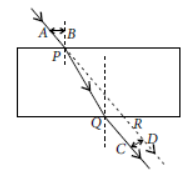
(a) AB
(b) PQ
(c) CD
(d) PR
Answer
C
Question. Aftger tracing the path of a ray of light passing through a rectangular glass slab for four different values of the angle of incidence, a student reported his observations in tabular form as given below:
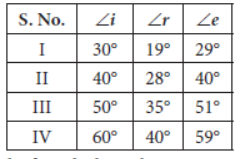
Out of the four the best observation is
(a) I
(b) II
(c) III
(d) IV
Answer
B
Question. A student has traced the path of a ray of light passing through a glass slab as follows. If you are asked to label 1, 2, 3 and 4, the correct sequencing of labelling ∠i, ∠e, ∠r and lateral displacement respectively is
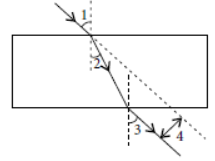
(a) 2, 1, 3, 4
(b) 1, 2, 3, 4
(c) 1, 3, 2, 4
(d) 1, 3, 4, 2
Answer
C
Question. While tracing the path of a ray of light passing through a rectangular glass slab, the four students I, II, III and IV arrived at the following different conclusions.
Student I : Angle of incidence > Angle of emergence.
Student II : Angle of refraction > Angle of emergence.
Student III : Emergent ray is parallel to refracted ray.
Student IV : Emergent ray is parallel to incident ray.
The correct conclusion has been drawn by the student
(a) I
(b) II
(c) III
(d) IV
Answer
D
Question. A student traces the path of a ray of light passing through a rectangular glass slab. 2
For measuring the angle of incidence, he must position the protractor in the manner shown in figure
(a) A
(b) B
(c) C
(d) D
Answer
B
Question. A student traces the path of a ray of light through a rectangular glass slab for the different values of angle of incidence. He observes all possible precautions at each step of the experiment. At the end of the experiment, on analysing the measurements, which of the following conclusions is he likely to draw?
(a) ∠i = ∠e < ∠r
(b) ∠i < ∠e < ∠r
(c) ∠i < ∠e > ∠r
(d) ∠i = ∠e > ∠r
Answer
D
Question. While tracing the path of a ray of light passing through a rectangular glass slab, a student tabulated his observations as given below :
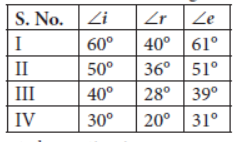
The best observation is
(a) I
(b) II
(c) III
(d) IV
Answer
D
Question. Four students P, Q, R and S traced the path of a ray of light passing through a glass slab for an angle of incidence 40° and measured the angle of refraction. ∠e values as measured by them were 18°, 22°, 25° and 30° respectively. ∠e student who has performed the experiment methodically is
(a) P
(b) Q
(c) R
(d) S
Answer
C
Question. Which of the following is the best experimental set-up out of the four shown for tracing the path of a ray of light passing through a rectangular glass slab?
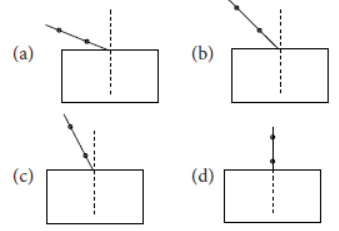
Answer
B
Question. A student traces the path of a ray of white light passing through a rectangular glass slab and marks the angles of incidence (∠i), refraction (∠r) and emergence (∠e) as shown. Which angle or angles has he not marked correctly?
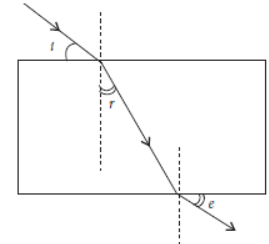
(a) ∠i only
(b) ∠i and ∠r
(c) ∠i and ∠e
(d) ∠r and ∠e
Answer
C
Question. A student very cautiously traces the path of a ray through a glass slab for different values of the angle of incidence (∠i). He then measures the corresponding values of the angle of refraction (∠r) and the angle of emergence (∠e) for every value of the angle of incidence.
On analysing these measurements of angles, his conclusion would be
(a) ∠i > ∠r > ∠e
(b) ∠i = ∠e > ∠r
(c) ∠i < ∠r < ∠e
(d) ∠i = ∠e < ∠r
Answer
B
Question. Rahim recorded the following sets of observations while tracing the path of a ray of light passing through a rectangular glass slab for different angles of incidence.
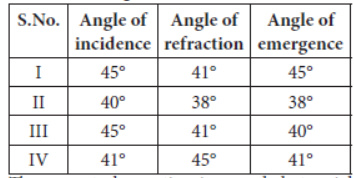
The correct observation is recorded at serial number
(a) I
(b) II
(c) III
(d) IV
Answer
A
Question. Select from the following the best experimental set-up for tracing the path of a ray of light passing through a rectangular glass slab.

(a) P
(b) Q
(c) R
(d) S
Answer
D
Question. The best set-up of pins for the incident ray to trace the path of a ray of light passing through a rectangular glass slab is represented in the figure.

(a) I
(b) II
(c) III
(d) IV
Answer
B
Question. In these diagrams, the angle of refraction for has been correctly marked in which diagram?

(a) I
(b) II
(c) III
(d) IV
Answer
D
Question. A student performs the experiment on tracing the path of a ray of light passing through a rectangular glass slab for different angles of incidence. He measures the angle of incidence ∠i, angle of refraction for and angle of emergence The for all his observations. He would Find that in all cases
(a) ∠i is more than ∠r but (nearly) equal to ∠e
(b) ∠i is less than ∠r but (nearly) equal to ∠e
(c) ∠i is more than ∠e but (nearly) equal to ∠r
(d) ∠i is less than ∠e but(nearly) equal to ∠r
Answer
A
Question. Four students A, B, C and D traced the paths of incident ray and the emergent ray by flxing pins P and Q for incident ray and pins R and S for emergent ray for a ray of light passing through a glass slab.
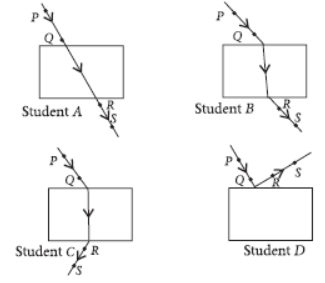
The correct emergent ray was traced by the student
(a) A
(b) B
(c) C
(d) D
Answer
B
Question. In the experiment on tracing the path of a ray of light passing through a rectangular glass slab, the correct setting of the protractor (D), for measuring the angle of incidence (∠i), and the angle of emergence (∠e), correspond, respectively, to diagrams is

(a) K and M
(b) K and N
(c) L and M
(d) L and N
Answer
A
Experiment – 5
Question. A student has to focus his compound microscope to observe a prepared slide showing different stages of binary fission in Amoeba. The steps he is likely to follow are listed below in a haphazard manner.
I. Adjust the diaphragm and the mirror of the microscope so that suficient light may enter to illuminate the slide.
II. Fix the slide on the stage carefully.
III. Adjust the microscope to high power and focus.
IV. Adjust the microscope to low power and focus.
The correct sequence of the above steps to observe the slide under the microscope is
(a) I, II, IV, III
(b) II, I, IV, III
(c) II, IV, I, III
(d) I, IV, II, III
Answer
B
Question. When you study a slide showing different stages of budding in yeast, you observe the following stages:
I. The bud may get separated from the parent body and develop into a new individual.
II. The body of the bud develops and gives rise to another baby bud.
III. A bud comes out in any direction from the body of the parent cell.
IV. Thus they may form a colony.
The proper sequence of the above stages is
(a) II, I, III, IV
(b) II, III, I, IV
(c) III, II, I, IV
(d) III, I, II, IV
Answer
C
Question. A student after viewing a prepared slide illustrates the budding in yeast in the following order which is not correct:

The correct order should be :
(a) B, C, D, E, A
(b) B, E, D, C, A
(c) B, D, E, C, A
(d) B, D, C, E, A
Answer
D
Question. Study the following statements about the process of budding in yeast.
I. A bud arises from a particular region of a parent body.
II. The parent cell divides into two daughter cells, here the parental identity is lost.
III. Before detaching from the parent body, a bud may form another bud.
IV. A bud when detaches from the parent body, grows into a new individual.
Select the correct statements :
(a) I, II and III
(b) II, III and IV
(c) I, III and IV
(d) I, II and IV
Answer
C
Question. Identify the figures showing the process of budding in yeast.

(a) I, II and III
(b) II, III and IV
(c) I, II and IV
(d) III, IV and I
Answer
C
Question. A student has to observe a permanent slide of binary fission in Amoeba. Find the correct sequence of steps given below for focussing the object under a microscope.
(A) Place the slide on the stage, look through the eye-piece and adjust the mirror to get proper illumination.
(B) Focus the slide sharp using fine adjustment screw.
(C) Look through the eye-piece and raise the objective lens using coarse adjustment screw till the object is focussed.
(D) Look through the eye-piece and move the slide till the object is visible.
(a) D, C, B, A
(b) A, B, D, C
(c) A, D, C, B
(d) A, C, D, B
Answer
C
Question. After viewing different slides, a student draws following diagrams. Select the one which depicts binary fission in Amoeba.
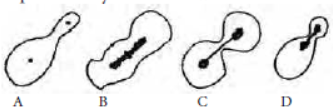
(a) A
(b) B
(c) C
(d) D
Answer
C
Question. After observing the prepared slides of binary fission in Amoeba and budding in yeast following observations were reported:
(A) Single cells of Amoeba and yeast were undergoing binary fission and budding respectively.
(B) Cytokinesis was observed in the yeast cell only.
(C) Elongated nucleus was dividing to form two daughter nuclei in Amoeba.
(D) A chain of buds were observed due to reproduction in Amoeba.
The correct observation (s) is/are:
(a) A and C
(b) B only
(c) C andD
(d) D, A and C.
Answer
A
Question. The four pictures of the microscope given below show the manner in which a microscope should be handled. e picture that shows the correct way of using the coarse adjustment while viewing through the high power objective is :
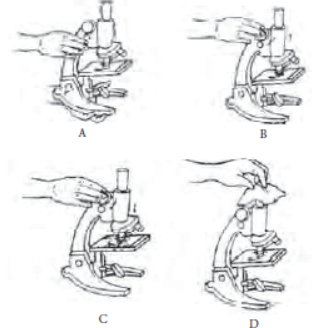
(a) A
(b) B
(c) C
(d) D
Answer
B
Question. The following figures illustrate binary fission in Amoeba in an incorrect sequences.
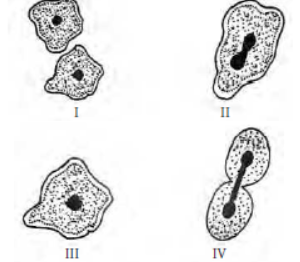
The correct sequence is
(a) III, II, IV, I
(b) III, IV, II, I
(c) II, III, IV, I
(d) IV, III, II, I.
Answer
A
Question. Following are the sketches drawn by four students P, Q, R and S. Which one of them does not illustrate budding in yeast?

(a) P
(b) Q
(c) R
(d) S
Answer
C
Question. After observing a slide, a student draws the following diagrams for different stages of binary fission in Amoeba which are not given in a correct sequence here.
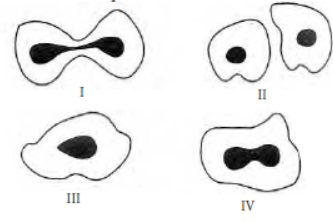
The correct sequence of these diagrams should be :
(a) III, IV, I, II
(b) IV, III, I, II
(c) III, I, IV, II
(d) IV, I, III, II.
Answer
A
Question. A student draws the following diagram after observing a prepared slide under a microscope. This illustrates

(a) bud formation in yeast
(b) formation of daughter cells in yeast
(c) binary fission in Amoeba
(d) pseudopodia formation in Amoeba.
Answer
C
Question. A prepared slide of budding in yeast was shown to the students of a class. Different students made different sketches on the basis of their memory. Out of these, four diagrams are shown below:

The correct diagram (s) is/are :
(a) I
(b) II
(c) I and IV
(d) II and III.
Answer
C
Question. Following diagrams were drawn by different students on having seen prepared slides of budding in yeast.

Correct diagrams are:
(a) I, II, III
(b) II, III, IV
(c) III, IV, V
(d) I, IV, V.
Answer
D
Question. Out of the given diagrams, the correctly labelled diagram showing budding in yeast is

(a) I
(b) II
(c) III
(d) IV
Answer
B
Question. A yeast cell in which budding occurs was seen to have
(a) one bud cell
(b) two bud cell
(c) three bud cell
(d) a chain of bud cells.
Answer
D
Question. A student was given two permanent slides, one of binary fission in Amoeba and other of budding in yeast. He was asked to identify any one difference in the nucleus of the two.
One such difference, he identified correctly was :
(a) Presence of one nucleus in Amoeba, two in yeast cell and one in bud.
(b) Presence of two nuclei in centrally constricted Amoeba, one in yeast cell and one in its bud.
(c) Presence of two distant nuclei in Amoeba, one in yeast cell and two in bud.
(d) Presence of a single nucleus each in Amoeba, yeast cell and its attached bud.
Answer
B
Question. Binary fission is observed in which one of the following figures?

(a) A
(b) B
(c) C
(d) D
Answer
C
Question. The shape of yeast cell is
(a) only spherical
(b) only oval
(c) irregular
(d) both oval and spherical.
Answer
D
Question. From the following diagrams, select the correct ones showing stages of binary fission in Amoeba:
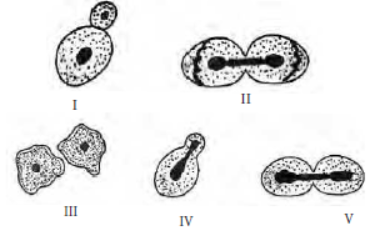
(a) I, II, III
(b) IV, II, III
(c) V, II, III
(d) IV, I, III
Answer
C
Question. After observing various slides showing different stages of binary fission in Amoeba, a student draws the following diagrams.
However, these diagrams may not be in proper sequence.
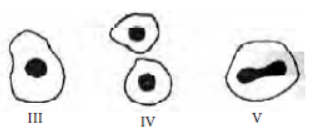
Identify the correct sequence of the above stages.
(a) III, II, I, V, IV
(b) III, V, II, I, IV
(c) III, I, II, V, IV
(d) III, II, V, I, IV
Answer
D
Question. The given figure illustrates binary fission in Amoeba in improper order.

The correct order is :
(a) III, IV, II, I
(b) IV, III, II, I
(c) II, III, IV, I
(d) I, III, IV, II.
Answer
C
Question. A slide shows a cell and another similar cell of smaller size attached to the tip of the first cell.
This slide could be of
(a) two buds of yeast
(b) yeast with a bud
(c) Amoeba with bud
(d) two daughter cells of Amoeba.
Answer
B
Question. A chain of yeast cells forms because
(a) yeast cells do not separate after budding
(b) daughter cells are unable to survive without parent cells
(c) buds reproduce as soon as they are formed
(d) daughter cells stick together with the help of mucus.
Answer
A
Question. The budding in yeast is illustrated by the following diagram:

(a) I
(b) II
(c) III
(d) IV
Answer
B
Question. The steps involved in observing a slide under a microscope are given below. They are not in proper sequence.
I. Focus the object under high power of the microscope.
II. Place the slide on the stage of the microscope.
III. Arrange the mirror to reflect maximum light to the slide.
IV. Focus the object under low power of the microscope.
The proper sequence of steps is
(a) II, III, IV, I
(b) I, II, III, IV
(c) IV, III, II, I
(d) III, I, II, IV.
Answer
A
Question.

The figures above are drawn from slides showing reproduction in yeast and Amoeba.
The correct description of the figure is :
(a) Amoeba undergoing binary fission is at a stage when nucleus is elongating, while yeast has undergone budding
(b) Yeast is undergoing binary fission and daughter nuclei have already formed, while a newly formed daughter Amoeba is undergoing growth
(c) The nucleus of a parent Amoeba is undergoing division to pass into its bud while yeast has already divided into two daughter cells
(d) Amoeba is undergoing cytokinesis and yeast is undergoing budding
Answer
A
Question. Four stages of binary fission in Amoeba are shown below. The stage at which nuclear fission and cytokinesis are observed is, stage

(a) I
(b) II
(c) III
(d) IV
Answer
B
Question. The two diagrams given below, aim to show the sequence of events for the binary fission in Amoeba and budding in yeast.
Binary fission in Amoeba

Buding in yeast

The correct sequence of events in the two diagrams respectively are
(a) (I, II, III, IV) and (V, VI, VII)
(b) (IV, III, II, I) and (VII, VI, V)
(c) (II, III, I, IV) and (VI, V, VII)
(d) (III, I, II, IV) and (VI, VII, V)
Answer
C
Question. In which of the following figures is budding not shown?

(a) I
(b) II
(c) III
(d) IV
Answer
A
Question. The process represented in the given diagram is :

(a) formation of bud taking place in Amoeba
(b) formation of daughter cells in Amoeba
(c) identical gametes being formed in Amoeba
(d) formation of spores in Amoeba.
Answer
B
Question. The given slides A and B were identified by four students I, II, III and IV as stated below:
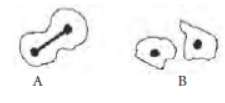

Of the above mentioned identifications of slides A and B, which one is correct?
(a) I
(b) II
(c) III
(d) IV
Answer
A
Question. A student is observing a permanent slide showing sequentially the different stages of asexual reproduction taking place in yeast.
Name this process and draw diagrams, of what he observes, in a proper sequence.
Answer
The process observed by the student is budding in yeast. It can be illustrated as follows :
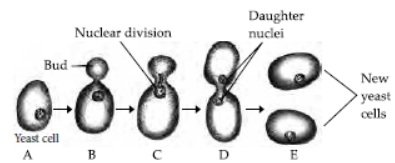
Question. Students were asked to observe the permanent slides showing different stages of budding in yeast under high power of a microscope.
(a) Which adjustment screw (coarse/fine) were you asked to move to focus the slides?
(b) Draw three diagrams in correct sequence showing budding in yeast.
Answer
(a) Coarse adjustment screw is used to focus the slides.
(b)

Question. In which asexual reproduction two individuals are formed from a single parent and the parental identity is lost? Draw the initial and the final stages of this type of reproduction to justify your answer. Write the event with which this process starts.
Answer
Binary fission is the type of asexual reproduction where two individuals are formed from a single parent and parental identity is lost. The unicellular organisms like, Amoeba,
Paramecium, etc., reproduce through binary fission. This process starts with karyokinesis.
When the Amoeba cell grows fully and reaches its maximum size, then first the nucleus of Amoeba lengthens and divides into two parts.

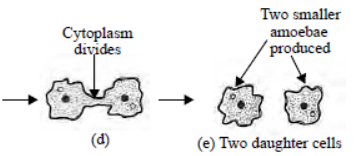
Question. Name the type of asexual reproduction in which two individuals are formed from a single parent and the parental identity is lost.
Write the first step from where such a type of reproduction begins. Draw first two stages of this reproduction.
Answer
Binary fission is the type of asexual reproduction in which two individuals are formed from a single parent and the parental identity is lost. This type of reproduction begins with the
division of parent cell when the nucleus starts dividing into two equal parts. The first two stages of this reproduction are as follows:

Question. Draw in sequence (showing the four stages), the process of binary fission in Amoeba.
Answer
The stages of binary fission in Amoeba in sequence are as follows.
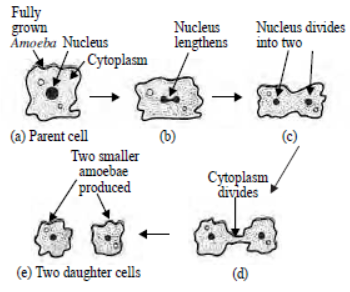
Experiment – 6
Question. Study the following figure in which a student has marked the angle of incidence (∠i), angle of refraction (∠r), angle of emergence (∠e), angle of prism (∠A) and the angle of deviation (∠D). The correctly marked angles are
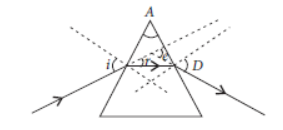
(a) ∠A and ∠i
(b) ∠A, ∠i and ∠r
(c) ∠A, ∠i, ∠e and ∠D
(d) ∠A, ∠i, ∠r and ∠D
Answer
A
Question. Study the following ray diagram.

In this diagram, the angle of incidence, the angle of emergence and the angle of deviation respectively have been represented by
(a) y, p, z
(b) x, q, z
(c) p, y, z
(d) p, z, y
Answer
C
Question. Consider the following traces of the path of a ray of light passing through a glass prism.
Identify the diagram which shows the correct path of a ray of light.

(a) I
(b) II
(c) III
(d) IV
Answer
C
Question. In an experiment to trace the path of a ray of light through a triangular glass prism, a student would observe that the emergent ray
(a) is parallel to the incident ray
(b) is along the same direction of incident ray
(c) gets deviated and bends towards the thinner part of the prism
(d) gets deviated and bends towards the thicker part (base) of the prism.
Answer
D
Question. A student traces the path of a ray of light through a triangular glass prism for different values of angle of incidence. On analysing the ray diagrams, which one of the following conclusions is he likely to draw?
(a) The emergent ray is parallel to the incident ray.
(b) The emergent ray bends at an angle to the direction of the incident ray.
(c) The emergent ray and the refracted ray are at right angles to each other.
(d) The emergent ray is perpendicular to the incident ray.
Answer
B
Question. In which of the following four diagrams is the correct path of a ray of light passing through a glass prism shown?
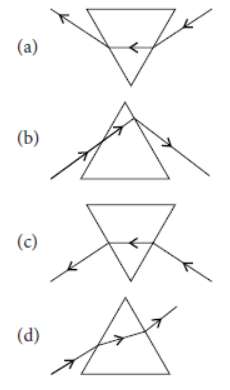
Answer
A
Question. In the following diagram the correctly marked angles are

(a) ∠A and ∠e
(b) ∠i, ∠A and ∠D
(c) ∠A, ∠r and ∠e
(d) ∠A, ∠r and ∠D
Answer
A
Question. You are tracing the path of a ray of light passing through a glass prism. The ideal angles of incidence would be between
(a) 10° and 20°
(b) 20° and 30°
(c) 35° and 60°
(d) 55° and 70°
Answer
C
Question. After tracing the path of a ray of light through a glass prism, a student marked the angle of incidence (∠i), angle of refraction (∠r), angle of emergence (∠e) and the angle of deviation (∠D) as shown in the diagram. ∠e correctly marked angles are

(a) ∠i and ∠r
(b) ∠i and ∠e
(c) ∠i, ∠e and ∠D
(d) ∠i, ∠r and ∠e
Answer
B
Experiment – 7
Question. A student has obtained a point image of a distant object using the given convex lens.
To find the focal length of the lens he should measure the distance between the
(a) lens and the object only
(b) lens and the screen only
(c) object and the image only
(d) lens and the object and also between the object and the image
Answer
B
Question. A student was given a convex lens of focal length 12 cm by his teacher to perform the experiment, ‘‘To find the image distance for various object distances in case of given convex lens.’’ He performed the experiment methodically observing all possible precautions and noted down his observations in tabular form as given below.

While checking, the teacher remarked that in one of the observations the image distance has not been recorded carefully. Identify the serial number of that observation.
(a) 2
(b) 3
(c) 4
(d) 6
Answer
B
Question. By using a convex lens, a student obtained a sharp image of his class-room window grill on a screen. In which direction should he move the lens to focus a distant tree instead of the grill?
(a) Towards the screen
(b) Away from the screen
(c) Very far away from the screen
(d) Behind the screen
Answer
A
Question. A teacher sets up the stand carrying a convex lens of focal length 15 cm at 42.7 cm mark on the optical bench. He asks four students A, B, C and D to suggest the position of screen on the optical bench so that a distinct image of a distant tree is obtained almost immediately on it. The positions suggested by the students were as
A. 12.7 cm B. 29.7 cm
C. 57.7 cm D. 72.7 cm
The correct positions of the screen was suggested by
(a) A
(b) B
(c) C
(d) D
Answer
C
Question. If you focus the image of a distant object, whose shape is given below, on a screen using a convex lens, the shape of the image of this object on the screen would be
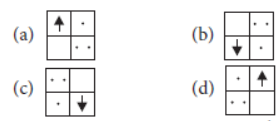
Answer
B
Question. A student obtains a blurred image of a distant object on a screen using a convex lens. To obtain a distinct image on the screen, he should move the lens
(a) away from the screen
(b) towards the screen
(c) to a position very far away from the screen
(d) either towards or away from the screen depending upon the position of the object
Answer
D
Question. A 4 cm tall object is placed on the principal axis of a convex lens. The distance of the object from the centre of the lens is 12 cm and its sharp image is formed at a distance of 24 cm from it on a screen on the other side of the lens. If the object is now moved a little away from the lens, in which way (towards the lens or away from the lens) will he have to move the screen to get a sharp image of the object on it again? How will the magnification of the image afected?
Answer
h = 4 cm, u = – 12 cm, v = 24 cm
∴ m = v/u = 24/-12 or |m | 2
If object is moved away from the lens, the screen should be moved towards the lens. As we move object away from lens, magnification is less than 2.
Question. A student places a 8.0 cm tall object perpendicular to the principal axis of a convex lens of focal length 20 cm. The distance of the object from the lens is 30 cm. He obtains a sharp image of the object on a screen placed on the other side of the lens. What will be the nature (inverted, erect, magnified, diminished) of the image he obtains on a screen? Draw ray diagram to justify your answer.
Answer
h = 8.0 cm, f = +20 cm, u = – 30 cm
As, 1/v – 1/u = 1/f
1/v = 1/f + 1/u = 1/20 – 1/30 = 3-2/60 = 1/60
v = + 60 cm
m = v/u = 60/-30 = -2
Image is real, inverted and magnified
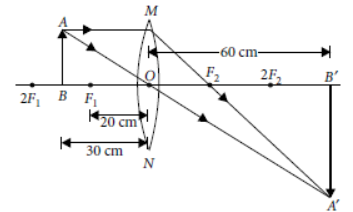
Question. A student places a candle flame at a distance of about 60 cm from a convex lens of focal length 10 cm and focuses the image of the flame on a screen. After that he gradually moves the flame towards the lens and each time focuses the image on the screen.
(i) In which direction – towards or away from the lens, does he move the screen to focus the image?
(ii) How does the size of the image change?
(iii) How does the intensity of the image change as the flame moves towards the lens?
(iv) Approximately for what distance between the flame and the lens, the image formed on the screen is inverted and of the same size?
Answer
u = – 60 cm, f = 10 cm
(i) As student moves the flame (i.e., object)
towards the lens, the object distance is decreasing.
As a result the image will move away from the lens. So, to focus the image, the student should gradually move the screen away from the lens.
(ii) Magnification, m = v/u
If u decreases and v increases, then m increases.
Hence, size of image increases as we move object towards the lens.
(iii) There is no effect on the intensity of focused image. If the screen is kept fixed and the object is moved towards the lens then the image formed is
blurred and of small size or we can say that it is of reduced intensity.
(iv) To obtain the image of same size, the object (flame) must be placed at 2f.
∴ u = 2f = 2 × 10 = 20 cm from lens.
Question. To find the image distance for varying object distances in case of a convex lens of focal length 15 cm, a student obtains on a screen a sharp image of a bright object by placing it at 20 cm distance from the lens. After that he gradually moves the object away from the lens and each time focuses the image on the screen.
(i) In which direction-towards or away from the lens does he move the screen to focus the object?
(ii) How does the size of image change?
(iii) Approximately at what distance does he obtain the image of magnification –1?
(iv) How does the intensity of image change as the object moves farther and farther away from the lens?
Answer
f = 15 cm, u = – 20 cm
(i) As the object is moving away from lens, the object distance is increasing.
∴ Image distance decreases.
Hence, the screen should be moved towards the lens to focus the image.
(ii) The size of image reduces as the object moves away from lens.
(iii) To obtain magnification – 1, the object must be placed at 2f from lens.
∴ u = 2 × 15 cm = 30 cm from lens.
As m = – 1
∴ |v| = |u| = 30 cm from lens (on the other side)
(iv) The intensity of image does not change as we move the object in either direction. The intensity of focused image is same.
Experiment – 8
Question. The students of a class were asked by the teacher to study the different parts of an embryo of an angiosperm. Given below are the essential steps for the experiment.
A. Soak the seeds in plain water and keep them overnight.
B. Cut open the soaked seed and observe its diferent parts.
C. Take some healthy seeds in a petri-dish.
D. Drain the excess water, cover the seeds with a wet cotton cloth and leave them as it is for a day.
The correct sequence of these steps is
(a) C, A, D, B
(b) C, D, A, B
(c) A, C, D, B
(d) A, C, B, D.
Answer
A
Question. A student is asked to study the different parts of an embryo of pea seeds. Given below are the essential steps for the experiment:
I Soak the pea seeds in plain water and keep them overnight.
II Cut open the soaked seed and observe its different parts.
III Take some pea seeds in a petri dish.
IV Drain the excess water. Cover the seeds with a wet cotton cloth and leave them as it is for a day.
The correct, sequence of these steps is
(a) III, I, IV, II
(b) III, IV, I, II
(c) III, I, II, IV
(d) III, II, I, IV.
Answer
A
Question. A student will be able to see the embryo of a gram seed when the dry gram seed is
(a) soaked in strong salt solution
(b) kept as it is
(c) soaked in plain water overnight
(d) soaked in oil.
Answer
C
Question. A student identified various parts of an embryo of a gram seed and listed them as given below:
I. Testa
II. Plumule
III. Radicle
IV. Cotyledon
V. Tegmen
Out of these the actual parts of the embryo are
(a) I, II, III
(b) II, III, IV
(c) III, IV, V
(d) II, IV, V
Answer
B
Question. A student has to perform the experiment “To identify the different parts of an embryo of a dicot seed”. Select from the following an appropriate group of seeds.
(a) Pea, gram, wheat
(b) Red kidney bean, maize, gram
(c) Maize, wheat, red kidney bean
(d) Red kidney bean, pea, gram
Answer
D
Question. A student while observing an embryo of a gram seed listed various parts of the embryo as listed below :
Testa, Micropyle, Cotyledon, Tegmen, Plumule, Radicle.
On examining the list the teacher commented that only three parts are correct. Select these correct parts.
(a) Cotyledon, Testa, Plumule
(b) Cotyledon, Plumule, Radicle
(c) Cotyledon, Tegmen, Radicle
(d) Cotyledon, Micropyle, Plumule
Answer
B
Question. You are asked by your teacher to study the different parts of an embryo of a gram seed.
Given below are the steps to be followed for the experiment.
I. Soak the gram seeds in plain water and keep them overnight.
II. Cut open the soaked seed and observe its different parts.
III. Take some dry gram seeds in a petri dish.
IV. Drain the excess water.
V. Cover the soaked seeds with a wet cotton cloth and leave them for a day.
The correct sequence of these steps is
(a) III, I, V, IV, II
(b) III, I, II, IV, V
(c) III, IV, V, I, II
(d) III, I, IV, V, II.
Answer
D
Question. In the following diagram showing the structure of embryo of a dicot seed, what are the parts marked I, II and III sequentially?

(a) Plumule, Cotyledon, Radicle
(b) Plumule, Radicle, Cotyledon
(c) Cotyledon, Plumule, Radicle
(d) Radicle, Plumule, Cotyledon
Answer
A
Question. A student while observing an embryo of a pea seed in the laboratory listed various parts of the embryo as given below:
Testa, Tegmen, Radicle, Plumule, Micropyle, Cotyledon On examining the list the teacher remarked that only three parts are correct. Select three correct parts from the above list :
(a) Testa, Radicle, Cotyledon
(b) Tegmen, Radicle, Micropyle
(c) Cotyledon, Plumule, Testa
(d) Radicle, Cotyledon, Plumule
Answer
D
Question. A student was asked to observe and identify the various parts of an embryo of a red kidney bean. He identified the parts and listed them as under
I. Tegmen
II. Testa
III. Cotyledon
IV. Radicle
V. Plumule
The correctly identified parts among these are
(a) I, II and III
(b) II, III and IV
(c) III, IV and V
(d) I, II, IV and V
Answer
C
Question. To perform an experiment to identify the different parts of an embryo of a dicot seed, first of all you require a dicot seed. Select dicot seeds from the following group Wheat, Gram, Maize, Pea, Barley, Groundnut
(a) Wheat, Gram and Pea
(b) Gram, Pea and Groundnut
(c) Maize, Pea and Barley
(d) Gram, Maize and Groundnut
Answer
B
Question. A student observed an embryo of a red kidney bean and identified four parts in it as
I. Cotyledon II. Plumule
III. Radicle IV. Tegmen
The correctly identified parts are
(a) I, II and III
(b) II, III and IV
(c) I, III and IV
(d) I, II and IV
Answer
A


